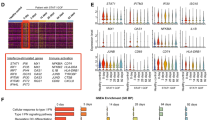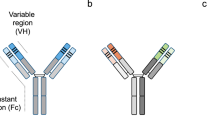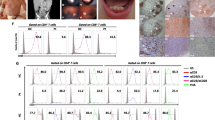Abstract
Autoimmune lymphoproliferative syndrome (ALPS), a disorder characterized by immune dysregulation due to disrupted lymphocyte homeostasis, is mainly resulted from the mutations in FAS-mediated apoptotic pathway. In addition, other mutations of the genes such as Fas-ligand (FASLG), Caspase 10 (CASP10) and Caspase 8 (CASP8), NRAS and KRAS have also been observed in a small number of patients with ALPS or ALPS-related disorders. However, approximately 20-30 % of patients with ALPS have unidentified defect. Its clinical manifestations observed in multiple family members include unexplained lymphadenopathy, hepatosplenomegaly, autoimmune cytopenias such as thrombocytopenia, neutropenia, and anemia due to excessive production of antibodies by lymphocytes, elevated number of double-negative T (DNT) cells, and increased risk of lymphoma. As a very rare disease, ALPS was first characterized in the early 1990s. More than 300 families with hereditary ALPS have been reported till now; nearly 500 patients from these families have been studied and followed worldwide over the last 20 years. ALPS has historically considered as a primary immune defect presenting in early childhood, however, recent studies have shown that it may be more common than previous thought because adult onset presentation is increasingly becoming recognized and more adult ALPS patients are diagnosed. The new genetic and biological insights have improved the understanding of ALPS and a number of targeted therapeutic strategies such as mycophenolate mofetil, sirolimus, and pentostatin have been successfully applied in ALPS patients with promising treatment efficacy. This article comprehensively reviews the clinical and laboratory manifestations, new research advances in the molecular pathogenesis, diagnosis and treatments of this disorder.


Similar content being viewed by others
References
Rao VK, Oliveira JB (2011) How I treat autoimmune lymphoproliferative syndrome. Blood 118:5741–5751
Canale VC, Smith CH (1967) Chronic lymphadenopathysimulating malignant Lymphoma.J. Paediatr 70:891–899
Sneller MC, Straus SE, Jaffe ES et al (1992) A novel lymphoproliferative⁄autoimmune syndrome resembling murinelpr⁄gld disease. J Clin Invest 90:334–341
Watanabe-Fukunaga R, Brannan CI, Copeland NG, Jenkins NA, Naqata S (1992) Lymphoproliferation disorder in mice explained by defects in Fas antigen that mediates apoptosis. Nature 356:314–317
Takahashi T, Tanaka M, Brannan CI et al (1994) Generalized lymphoproliferative disease in mice, caused by a point mutation in the Fas ligand. Cell 76:969–976
Rieux-Laucat F, Le Deist F, Hivroz C et al (1995) Mutations in Fas associated with human lymphoproliferative syndrome and autoimmunity. Science 268:1347–1349
Fisher GH, Rosenberg FJ, Straus SE et al (1995) Dominant interfering Fas gene mutations impair apoptosis in a human autoimmune lymphoproliferative syndrome. Cell 81:935–946
Worth A, Thrasher AJ H, Gaspar HB (2006) Autoimmune lymphoproliferative syndrome: molecular basis of disease and clinical phenotype. Br J Haematol 133:124–140
Hansford JR, Pal M, Poplawski N et al (2013) In utero and early postnatal presentation of autoimmune lymphoproliferative syndrome in a family with a novel FAS mutation. Haematologica 98:e38–e39
Deutsch M, Tsopanou E, Dourakis SP (2004) The autoimmune lymphoproliferative syndrome (Canale-Smith) in adulthood. Clin Rheumatol 23:43–44
der Werff V, ten Bosch J (2003) Autoimmune lymphoproliferative syndrome: etiology, diagnosis, and management. Paediatr Drugs 5:185–193
Teachey DT, Seif AE, Grupp SA (2010) Advances in the management and understanding of autoimmune lymphoproliferative syndrome (ALPS). Br J Haematol 148:205–216
Jackson CE, Puck JM (1999) Autoimmune lymphoproliferative syndrome, a Disorder of apoptosis. Curr Opin Pediatr 11:521–527
Straus SE, Jaffe ES, Puck JM et al (2001) The development of lymphomas in families with autoimmune lymphoproliferative syndrome with germline Fas mutations and defective lymphocyte apoptosis. Blood 98:194–200
Teachey DT, Manno CS, Axsom KM et al (2005) Unmasking Evans syndrome: T-cell phenotype and apoptotic response reveal autoimmune lymphoproliferative syndrome (ALPS). Blood 105:2443–2448
Madkaikar M, Mhatre S, Gupta M, Ghosh K (2011) Advances in autoimmune lymphoproliferative syndromes. Eur J Haematol 87:1–9
Teachey DT (2012) New advances in the diagnosis and treatment of autoimmune lymphoproliferative syndrome. Curr Opin Pediatr 24:1–8
Oliveira JB, Bleesing JJ, Dianzani U et al (2010) Revised diagnostic criteria and classification for the autoimmune lymphoproliferative syndrome: report from the 2009 NIH International Workshop. Blood 116:e35–e40
Bleesing JJ, Brown MR, Novicio C (2002) A composite picture of TcR alpha/ beta (+) CD4(−)CD8(+) T Cells (alpha/beta-DNTCs) in humans with autoimmune lymphoproliferative syndrome. Clin Immunol 104:21–30
Bleesing JJ, Brown MR, Dale JK et al (2001) TcR-alpha/beta (+) CD4(−)CD8(+)T cells in humans with the autoimmune lymphoproliferative syndrome express a novel CD45 isoform that is analogous to murine B220 and represents a marker of altered O-glycan biosynthesis. Clin Immunol 100:314–324
Fischer K, Voelkl S, Heymann J et al (2005) Isolation and characterization of human antigen-specific TCR alpha beta + CD4(−)CD8(+) double-negative regulatory T cells. Blood 105:2828–2835
Muppidi J, Porter M, Siegel RM (2004) Measurement of apoptosis and other forms of cell death. Curr Protoc Immunol. Chapter 3:Unit 3.17
Holzelova E, Vonarbourg C, Stolzenberg MC et al (2004) Autoimmune lymphoproliferative syndrome with somatic Fas mutations. N Engl J Med 351:1409–1418
Straus SE, Sneller M, Lenardo MJ, Puck JM, Strober W (1999) An inherited disorder of lymphocyte apoptosis: the autoimmune lymphoproliferative syndrome. Ann Intern Med 130:591–601
Caminha I, Fleisher TA, Hornung RL et al (2010) Using biomarkers to predict the presence of FAS mutations in patients with features of the autoimmune lymphoproliferative syndrome. J Allergy Clin Immunol 125:946–949
Bowen RA, Dowdell KC, Dale JK et al (2012) Elevated vitamin B12 levels in autoimmune lymphoproliferative syndrome attributable to elevated haptocorrin in lymphocytes. Clin Biochem 45:490–492
Neven B, Magerus-Chatinet A, Florkin B et al (2011) A survey of 90 patients with autoimmune lymphoproliferative syndrome related to TNFRSF6 mutation. Blood 118:4798–4807
Campagnoli MF, Garbarini L, Quarello P et al (2006) The broad spectrum of autoimmune lymphoproliferative disease:molecular bases, clinical features and long-term follow-up in 31 patients. Haematologica 91:538–541
Price S, Shaw PA, Seitz A et al (2014) Natural history of autoimmune lymphoproliferative syndrome associated with FAS gene mutations. Blood 123:1989–1999
Bleesing JJ, Straus SE, Fleisher TA (2000) Autoimmune lymphoproliferative syndrome. A human disorder of abnormal lymphocyte survival. Pediatr Clin North Am 47:1291–1310
Rao VK, Straus SE (2006) Causes and consequences of the autoimmune lymphoproliferative syndrome. Hematology 11:15–23
Chun HJ, Zheng L, Ahmad M et al (2002) Pleiotropic defects in lymphocyte activation caused by caspase-8 mutations lead to human immunodeficiency. Nature 419:395–399
Shah S, Wu E, Rao VK, Tarrant TK (2014) Autoimmune lymphoproliferative syndrome: an update and review of the literature. Curr Allergy Asthma Rep 14:462
Simesen de Bielke MG, Yancoski J, Rocco C et al (2012) A missense mutation in the extracellular domain of Fas: the most common change in Argentinean patients with autoimmune lymphoproliferative syndrome represents a founder effect. J Clin Immunol 32:1197–1203
Tadaki H, Saitsu H, Kanegane H et al (2011) Exonic deletion of CASP10 in a patient presenting with systemic juvenile idiopathic arthritis, but not with autoimmune lymphoproliferative syndrome type IIa. Int J Immunogenet 38:287–293
Aricò M, Boggio E, Cetica V et al (2013) Variations of the UNC13D gene in patients with autoimmune lymphoproliferative syndrome. PLoS One 8:e68045
Takagi M, Shinoda K, Piao J et al (2011) Autoimmune lymphoproliferative syndrome-like disease with somatic KRAS mutation. Blood 117:2887–2890
Niemela JE, Lu L, Fleisher TA et al (2011) Somatic KRAS mutations associated with a human nonmalignant syndrome of autoimmunity and abnormal leukocyte homeostasis. Blood 117:2883–2886
Guo Q, Zhang J, Li J et al (2013) Forced miR-146a expression causes autoimmune lymphoproliferativesyndrome in mice via downregulation of Fas in germinal center B cells. Blood 121:4875–4883
Dowdell KC, Niemela JE, Price S et al (2010) Somatic FAS mutations are common in patients with genetically undefined autoimmune lymphoproliferative syndrome. Blood 115:5164–5169
Oliveira JB, Bidere N, Niemela JE et al (2007) NRAS mutation causes a human autoimmune lymphoproliferative syndrome. Proc Natl Acad Sci U S A 104:8953–8958
Dianzani U, Bragardo M, DiFranco D et al (1997) Deficiency of the Fas apoptosis pathway without Fas gene mutations in pediatric patients with autoimmunity/lymphoproliferation. Blood 89:2871–2879
Ramenghi U, Bonissoni S, Migliaretti G et al (2000) Deficiency of the Fas apoptosis pathway without Fas gene mutations is a familial trait predisposing to development of autoimmune diseases and cancer. Blood 95:3176–3182
Snow AL, Marsh RA, Krummey SM et al (2009) Restimulation-induced apoptosis of T cells is impaired in patients with X-linked lymphoproliferative disease caused by SAP deficiency. J Clin Invest 119:2976–2989
Rudman Spergel A, Walkovich K, Price S et al (2013) Autoimmune lymphoproliferative syndrome misdiagnosed as hemophagocytic lymphohistiocytosis. Pediatrics 132:e1440–e1444
Nomura K, Kanegane H, Otsubo K et al (2011) Autoimmune lymphoproliferative syndrome mimicking chronic active Epstein-Barr virus infection. Int J Hematol 93:760–764
Rao VK, Price S, Perkins K et al (2009) Use of rituximab for refractory cytopenias associated with autoimmune lymphoproliferative syndrome (ALPS). Pediatric Blood Cancer 52:847–852
Cooper N, Davies EG, Thrasher AJ (2009) Repeated courses of rituximab for autoimmune cytopenias may precipitate profound hypogammaglobulinaemia requiring replacement intravenous immunoglobulin. Br J Haematol 146:120–122
Neven B, Bruneau J, Stolzenberg MC et al (2014) Defective anti-polysaccharide response and splenic marginal zone disorganization in ALPS patients. Blood 124:1597–1609
Arora S, Singh N, Chaudhary GK, John MJ (2011) Autoimmune lymphoproliferative syndrome: response to mycophenolate mofetil and pyrimethamine/sulfadoxine in a 5-year-old child. Indian J Hematol Blood Transfus 27:101–103
Teachey DT, Greiner R, Seif A et al (2009) Treatment with sirolimus results in complete responses in patients with autoimmune lymphoproliferative syndrome. Br J Haematol 145:101–106
Bajwa R, Savelli S, Gross T (2011) Pentostatin for treatment of refractory autoimmune lymphoproliferative syndrome. Pediatr Blood Cancer 57:336–337
Rao VK, Dugan F, Dale JK et al (2005) Use of mycophenolate mofetil for chronic, refractory immune cytopenias in children with autoimmune lymphoproliferative syndrome. Br J Haematol 129:534–538
Bobé P, Bonardelle D, Benihoud K et al (2006) Arsenic trioxide: a promising novel therapeutic agent for lymphoproliferative and autoimmune syndromes in MRL/lpr mice. Blood 108:3967
Dowdell KC, Pesnicak L, Hoffmann V et al (2009) Valproic acid (VPA), a histone deacetylase (HDAC) inhibitor, diminishes lymphoproliferation in the Fas deficient MRL/lpr(−/−) murine model of autoimmune lymphoproliferative syndrome (ALPS). Exp Hematol 37:487–494
Acknowledgments
This work was financially supported by the grants of the Science and Technology Project from Education Department of Jiangxi province (GJJ14021) and the Natural Science Foundation of Jiangxi province (20142BAB205072)
Conflict of interest
The authors declare no conflict of interest.
Author information
Authors and Affiliations
Corresponding author
Additional information
Author’ contributions
P.L. designed and wrote the manuscript. P.H. contributed to manuscript revision and final manuscript review. Y.Y., M.H., and H.P. contributed to manuscript revision. F.L. contributed to the design of the review and the approval of the final manuscript.
Pu Li and Ping Huang contributed equally to this work.
Rights and permissions
About this article
Cite this article
Li, P., Huang, P., Yang, Y. et al. Updated Understanding of Autoimmune Lymphoproliferative Syndrome (ALPS). Clinic Rev Allerg Immunol 50, 55–63 (2016). https://doi.org/10.1007/s12016-015-8466-y
Published:
Issue Date:
DOI: https://doi.org/10.1007/s12016-015-8466-y




